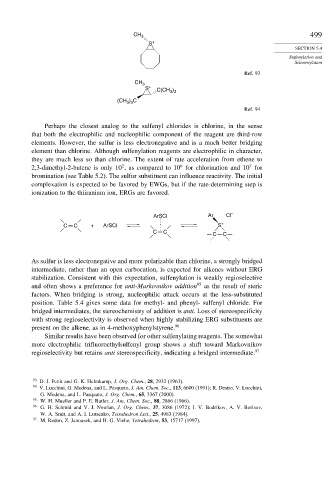Page 518 - Advanced Organic Chemistry Part A - Structure and Mechanisms, 5th ed (2007) - Carey _ Sundberg
P. 518
CH 3 499
S +
SECTION 5.4
Sulfenylation and
Selenenylation
Ref. 93
CH 3
S + C(CH )
3 3
(CH ) C
3 3
Ref. 94
Perhaps the closest analog to the sulfenyl chlorides is chlorine, in the sense
that both the electrophilic and nucleophilic component of the reagent are third-row
elements. However, the sulfur is less electronegative and is a much better bridging
element than chlorine. Although sulfenylation reagents are electrophilic in character,
they are much less so than chlorine. The extent of rate acceleration from ethene to
2
6
7
2,3-dimethyl-2-butene is only 10 , as compared to 10 for chlorination and 10 for
bromination (see Table 5.2). The sulfur substituent can influence reactivity. The initial
complexation is expected to be favored by EWGs, but if the rate-determining step is
ionization to the thiiranium ion, ERGs are favored.
ArSCl Ar Cl –
C C + ArSCl S +
C C C C
As sulfur is less electronegative and more polarizable than chlorine, a strongly bridged
intermediate, rather than an open carbocation, is expected for alkenes without ERG
stabilization. Consistent with this expectation, sulfenylation is weakly regioselective
and often shows a preference for anti-Markovnikov addition 95 as the result of steric
factors. When bridging is strong, nucleophilic attack occurs at the less-substituted
position. Table 5.4 gives some data for methyl- and phenyl- sulfenyl chloride. For
bridged intermediates, the stereochemistry of addition is anti. Loss of stereospecificity
with strong regioselectivity is observed when highly stabilizing ERG substituents are
present on the alkene, as in 4-methoxyphenylstyrene. 96
Similar results have been observed for other sulfenylating reagents. The somewhat
more electrophilic trifluoroethylsulfenyl group shows a shift toward Markovnikov
regioselectivity but retains anti stereospecificity, indicating a bridged intermediate. 97
93 D. J. Pettit and G. K. Helmkamp, J. Org. Chem., 28, 2932 (1963).
94
V. Lucchini, G. Modena, and L. Pasquato, J. Am. Chem. Soc., 113, 6600 (1991); R. Destro, V. Lucchini,
G. Modena, and L. Pasquato, J. Org. Chem., 65, 3367 (2000).
95 W. H. Mueller and P. E. Butler, J. Am. Chem. Soc., 88, 2866 (1966).
96 G. H. Schmid and V. J. Nowlan, J. Org. Chem., 37, 3086 (1972); I. V. Bodrikov, A. V. Borisov,
W. A. Smit, and A. I. Lutsenko, Tetrahedron Lett., 25, 4983 (1984).
97
M. Redon, Z. Janousek, and H. G. Viehe, Tetrahedron, 53, 15717 (1997).

